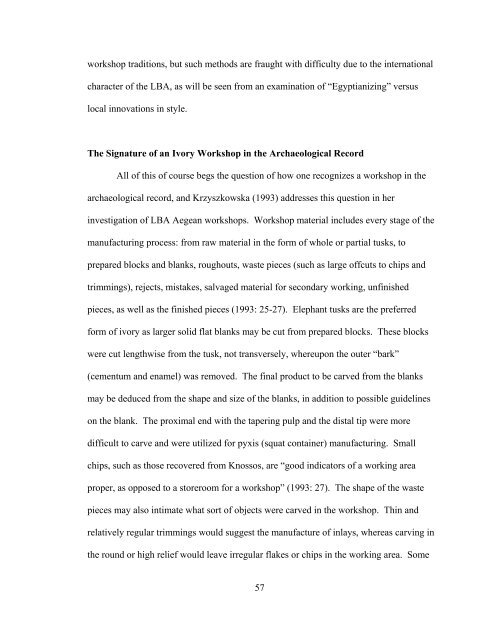Tracing the Source of the Elephant And Hippopotamus Ivory from ...
Tracing the Source of the Elephant And Hippopotamus Ivory from ...
Tracing the Source of the Elephant And Hippopotamus Ivory from ...
Create successful ePaper yourself
Turn your PDF publications into a flip-book with our unique Google optimized e-Paper software.
workshop traditions, but such methods are fraught with difficulty due to <strong>the</strong> international<br />
character <strong>of</strong> <strong>the</strong> LBA, as will be seen <strong>from</strong> an examination <strong>of</strong> “Egyptianizing” versus<br />
local innovations in style.<br />
The Signature <strong>of</strong> an <strong>Ivory</strong> Workshop in <strong>the</strong> Archaeological Record<br />
All <strong>of</strong> this <strong>of</strong> course begs <strong>the</strong> question <strong>of</strong> how one recognizes a workshop in <strong>the</strong><br />
archaeological record, and Krzyszkowska (1993) addresses this question in her<br />
investigation <strong>of</strong> LBA Aegean workshops. Workshop material includes every stage <strong>of</strong> <strong>the</strong><br />
manufacturing process: <strong>from</strong> raw material in <strong>the</strong> form <strong>of</strong> whole or partial tusks, to<br />
prepared blocks and blanks, roughouts, waste pieces (such as large <strong>of</strong>fcuts to chips and<br />
trimmings), rejects, mistakes, salvaged material for secondary working, unfinished<br />
pieces, as well as <strong>the</strong> finished pieces (1993: 25-27). <strong>Elephant</strong> tusks are <strong>the</strong> preferred<br />
form <strong>of</strong> ivory as larger solid flat blanks may be cut <strong>from</strong> prepared blocks. These blocks<br />
were cut lengthwise <strong>from</strong> <strong>the</strong> tusk, not transversely, whereupon <strong>the</strong> outer “bark”<br />
(cementum and enamel) was removed. The final product to be carved <strong>from</strong> <strong>the</strong> blanks<br />
may be deduced <strong>from</strong> <strong>the</strong> shape and size <strong>of</strong> <strong>the</strong> blanks, in addition to possible guidelines<br />
on <strong>the</strong> blank. The proximal end with <strong>the</strong> tapering pulp and <strong>the</strong> distal tip were more<br />
difficult to carve and were utilized for pyxis (squat container) manufacturing. Small<br />
chips, such as those recovered <strong>from</strong> Knossos, are “good indicators <strong>of</strong> a working area<br />
proper, as opposed to a storeroom for a workshop” (1993: 27). The shape <strong>of</strong> <strong>the</strong> waste<br />
pieces may also intimate what sort <strong>of</strong> objects were carved in <strong>the</strong> workshop. Thin and<br />
relatively regular trimmings would suggest <strong>the</strong> manufacture <strong>of</strong> inlays, whereas carving in<br />
<strong>the</strong> round or high relief would leave irregular flakes or chips in <strong>the</strong> working area. Some<br />
57

















